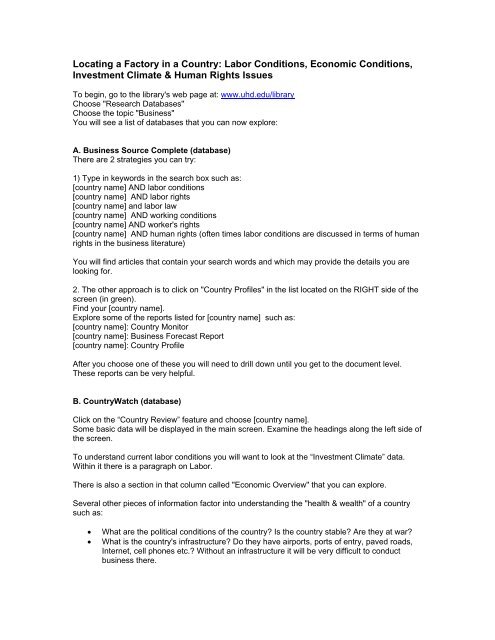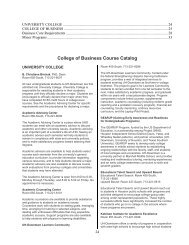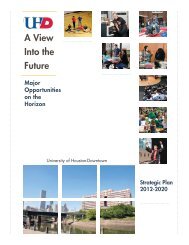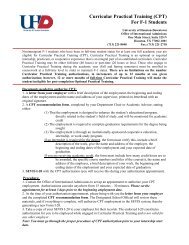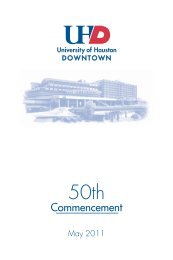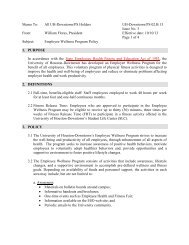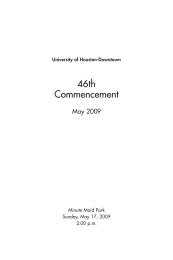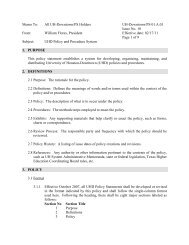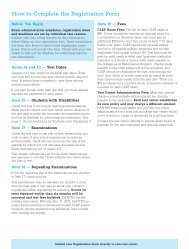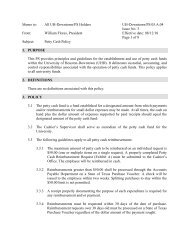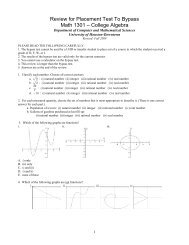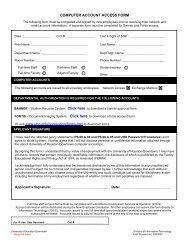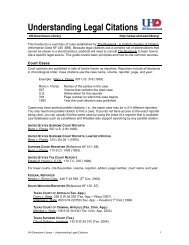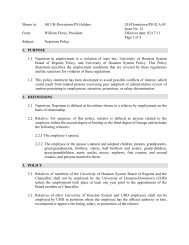Locating a Factory in a Country: Labor Conditions, Economic ...
Locating a Factory in a Country: Labor Conditions, Economic ...
Locating a Factory in a Country: Labor Conditions, Economic ...
Create successful ePaper yourself
Turn your PDF publications into a flip-book with our unique Google optimized e-Paper software.
<strong>Locat<strong>in</strong>g</strong> a <strong>Factory</strong> <strong>in</strong> a <strong>Country</strong>: <strong>Labor</strong> <strong>Conditions</strong>, <strong>Economic</strong> <strong>Conditions</strong>,<br />
Investment Climate & Human Rights Issues<br />
To beg<strong>in</strong>, go to the library's web page at: www.uhd.edu/library<br />
Choose "Research Databases"<br />
Choose the topic "Bus<strong>in</strong>ess"<br />
You will see a list of databases that you can now explore:<br />
A. Bus<strong>in</strong>ess Source Complete (database)<br />
There are 2 strategies you can try:<br />
1) Type <strong>in</strong> keywords <strong>in</strong> the search box such as:<br />
[country name] AND labor conditions<br />
[country name] AND labor rights<br />
[country name] and labor law<br />
[country name] AND work<strong>in</strong>g conditions<br />
[country name] AND worker's rights<br />
[country name] AND human rights (often times labor conditions are discussed <strong>in</strong> terms of human<br />
rights <strong>in</strong> the bus<strong>in</strong>ess literature)<br />
You will f<strong>in</strong>d articles that conta<strong>in</strong> your search words and which may provide the details you are<br />
look<strong>in</strong>g for.<br />
2. The other approach is to click on "<strong>Country</strong> Profiles" <strong>in</strong> the list located on the RIGHT side of the<br />
screen (<strong>in</strong> green).<br />
F<strong>in</strong>d your [country name].<br />
Explore some of the reports listed for [country name] such as:<br />
[country name]: <strong>Country</strong> Monitor<br />
[country name]: Bus<strong>in</strong>ess Forecast Report<br />
[country name]: <strong>Country</strong> Profile<br />
After you choose one of these you will need to drill down until you get to the document level.<br />
These reports can be very helpful.<br />
B. <strong>Country</strong>Watch (database)<br />
Click on the “<strong>Country</strong> Review” feature and choose [country name].<br />
Some basic data will be displayed <strong>in</strong> the ma<strong>in</strong> screen. Exam<strong>in</strong>e the head<strong>in</strong>gs along the left side of<br />
the screen.<br />
To understand current labor conditions you will want to look at the “Investment Climate” data.<br />
With<strong>in</strong> it there is a paragraph on <strong>Labor</strong>.<br />
There is also a section <strong>in</strong> that column called "<strong>Economic</strong> Overview" that you can explore.<br />
Several other pieces of <strong>in</strong>formation factor <strong>in</strong>to understand<strong>in</strong>g the "health & wealth" of a country<br />
such as:<br />
• What are the political conditions of the country? Is the country stable? Are they at war?<br />
• What is the country's <strong>in</strong>frastructure? Do they have airports, ports of entry, paved roads,<br />
Internet, cell phones etc.? Without an <strong>in</strong>frastructure it will be very difficult to conduct<br />
bus<strong>in</strong>ess there.
• What are the environmental regulations? Maybe it will cost you more to do bus<strong>in</strong>ess there<br />
if there are tight regulations.<br />
These questions can be answered by explor<strong>in</strong>g the other sections <strong>in</strong> <strong>Country</strong>watch such as<br />
"Environmental Overview" and "Political Overview." (Infrastructure <strong>in</strong>formation is <strong>in</strong>cluded <strong>in</strong> the<br />
"Investment Climate" section).<br />
Look for this type of data whenever you are look<strong>in</strong>g at country <strong>in</strong>formation.<br />
C. Bus<strong>in</strong>ess & Human Rights Resource Center<br />
Go to http://www.uhd.edu/library/websites/<strong>in</strong>ternationalbus<strong>in</strong>ess.html<br />
Choose "Bus<strong>in</strong>ess & Human Rights Resource Center"<br />
Important Note: Often the <strong>in</strong>formation needed regard<strong>in</strong>g the treatment of workers is not found<br />
under “labor” but is <strong>in</strong>stead considered “human rights” <strong>in</strong>formation.<br />
Choose “Regions/Countries” on the left side of the screen. Choose "Americas" and then choose<br />
[country name].<br />
This will produce a huge list of reports that each has some content regard<strong>in</strong>g how people are<br />
be<strong>in</strong>g treated <strong>in</strong> that country – either from an employment po<strong>in</strong>t of view or with regard to their<br />
personal freedoms. Please take the time to review some of these.<br />
At the top of this list of reports are some tabs or topic choices. To focus on a few good reports try<br />
click<strong>in</strong>g on "<strong>Country</strong> Overview."<br />
The list of documents is narrowed down. At the bottom of the list on the first page is a report<br />
called "U.S. State Department <strong>Country</strong> Reports on Human Rights Practices 2004: [country name]<br />
" (if it isn't on the first page scroll to the next until you f<strong>in</strong>d it). This report is from the U.S. State<br />
Department Bureau of Democracy, Human Rights and <strong>Labor</strong>.<br />
Open this document.<br />
With<strong>in</strong> this document there is a section (“Section 5”) entitled discrim<strong>in</strong>ation Based on Race, Sex,<br />
Disability, Language, or Social Status”. This section will conta<strong>in</strong> <strong>in</strong>formation regard<strong>in</strong>g the<br />
treatment of women as well as children - such as their treatment <strong>in</strong> society (which <strong>in</strong>cludes the<br />
workplace). Also look at Section 6, “Worker Rights,” which will have material.<br />
Also look for reports from Amnesty International as well as UNICEF’s “Child <strong>Labor</strong> Today” report.<br />
D GlobalEdge Resource Desk<br />
Go to http://www.uhd.edu/library/websites/<strong>in</strong>ternationalbus<strong>in</strong>ess.html<br />
Choose "GlobalEdge Resource Desk"<br />
Scroll to your country us<strong>in</strong>g the “Jump To..” country search box <strong>in</strong> the upper right of the screen.<br />
Navigate the different sections of the report such as "Economy" and "Statistics" us<strong>in</strong>g the l<strong>in</strong>ks on<br />
the left under “Navigation”
E.CIA World Fact Book<br />
Go to http://www.uhd.edu/library/websites/countries.html<br />
Choose "CIA World Factbook"<br />
Select your country from the pull-down menu.<br />
Explore the different categories available <strong>in</strong>clud<strong>in</strong>g “Economy”<br />
Under Economy there are some statistics that address “<strong>Labor</strong> Force by Occupation”. Broadly<br />
speak<strong>in</strong>g, a labor force that is high <strong>in</strong> services versus agriculture may have a higher skilled<br />
workforce or may have a higher educated workforce (professional or “white collar work” is<br />
<strong>in</strong>cluded <strong>in</strong> the “services” statistic).<br />
These are some of the highlights for f<strong>in</strong>d<strong>in</strong>g <strong>in</strong>formation on labor conditions on a country us<strong>in</strong>g the<br />
library's resources. If you choose to search the web us<strong>in</strong>g Google please remember to search on<br />
both "labor" and "labour" s<strong>in</strong>ce there will be <strong>in</strong>formation from sources other than with<strong>in</strong> the US.


